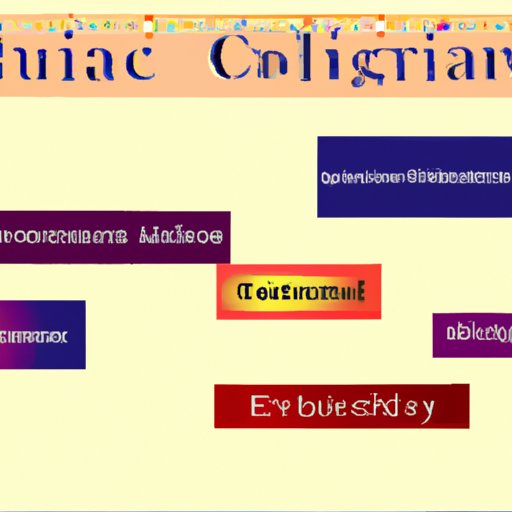Introduction
Culture can be defined as a set of shared attitudes, values, goals, and practices that characterize a particular group of people. It is often expressed through language, customs, beliefs, and traditions, and it is constantly changing and evolving over time. Cultural identity is an important concept that helps us understand how culture manifests itself in different ways.

Exploring Cultural Identity Through Language
Language is a powerful tool for understanding and expressing culture. The words we use to communicate are often steeped in cultural meaning and symbolism. For example, certain words may carry connotations or evoke emotions that are specific to a particular culture. In addition, language can be used to draw connections between cultural groups and help build bridges of understanding between them. By exploring the linguistic nuances of different cultures, we can gain insight into their unique identities.
Language also plays a key role in shaping cultural identity. In many cases, language is closely associated with a person’s sense of belonging and identity. People who share the same language often have similar values and beliefs, which can lead to a strong sense of community and solidarity. This connection between language and identity can be seen in many parts of the world, from indigenous communities to immigrant populations.
Examining Cultural Stereotypes and Prejudice
Stereotypes are generalizations about a group of people based on shared characteristics. They can be positive or negative, but they often lead to prejudice and discrimination. Stereotypes are perpetuated through media, popular culture, and other forms of communication. They can also be reinforced by personal experiences or interactions with others.
Prejudice is a deep-seated attitude or belief about a group of people that is usually negative. It is often rooted in ignorance and misinformation, and it can lead to discriminatory behavior. Understanding the origins of stereotypes and prejudice can help us better recognize and combat them.
Investigating the Influence of Religion on Culture
Religion is a major source of cultural identity. Faith can shape a person’s beliefs and values, and it can influence their behavior and lifestyle. Many religions have distinct rituals and traditions that are closely tied to cultural customs. For example, Hinduism has a long history of influencing Indian culture and society. Similarly, Islam has a strong presence in many parts of the Middle East and North Africa.
Religion can also be a source of tension between different cultural groups. Conflicts between religious groups can have serious implications for social cohesion and stability, and they can lead to violence and other forms of conflict. Understanding the role that religion plays in shaping culture can help us better navigate these complex issues.
Analyzing Social Norms and Folkways
Social norms and folkways are unwritten rules and expectations that govern behavior in a particular culture. These norms and folkways can vary greatly from one culture to another, and they can be very influential in shaping behavior. For example, in some cultures, it may be considered rude to make direct eye contact with someone you don’t know. In other cultures, direct eye contact might be seen as a sign of respect.
Social norms and folkways can also be used to reinforce certain values and beliefs. For example, in some cultures, it may be considered taboo to talk about certain topics in public. This can be used to discourage people from discussing sensitive or controversial subjects. Understanding the impact of social norms and folkways can provide insight into the values and beliefs of a particular culture.

Exploring Artistic Expression in Different Cultures
Artistic expression is an important part of many cultures. Different cultures have their own unique forms of art, music, dance, and other forms of creative expression. These forms of expression can be used to convey cultural values and beliefs, and they can be a powerful tool for building bridges between cultures.
Art can also be a way of preserving cultural heritage. Many cultures have traditional forms of art that have been passed down through generations. These forms of art can provide insight into the history and values of a particular culture. Exploring the different forms of artistic expression across cultures can help us gain a deeper understanding of their unique identities.

Examining Cultural Values and Beliefs
Values and beliefs play a central role in defining culture. They provide a framework for understanding the world and determining how people should behave. Values and beliefs can shape behaviors and attitudes, and they can be used to guide decision-making. For example, in some cultures, family loyalty may be seen as a core value, while in others, individual freedom may be more highly valued.
Values and beliefs can also be used to draw connections between different cultures. By exploring the similarities and differences between values and beliefs, we can gain insight into how cultures interact and influence each other. Understanding the role that values and beliefs play in defining culture can help us appreciate the diversity of human experience.
Conclusion
Culture manifests itself in many different ways, from language and customs to art and values. By exploring how culture manifests itself, we can gain a better understanding of its role in shaping our identities and behavior. From examining language and stereotypes to investigating the influence of religion and social norms, there are many different ways to explore the study of culture. We can use this knowledge to foster greater understanding and appreciation of the diversity of human cultures.
(Note: Is this article not meeting your expectations? Do you have knowledge or insights to share? Unlock new opportunities and expand your reach by joining our authors team. Click Registration to join us and share your expertise with our readers.)
